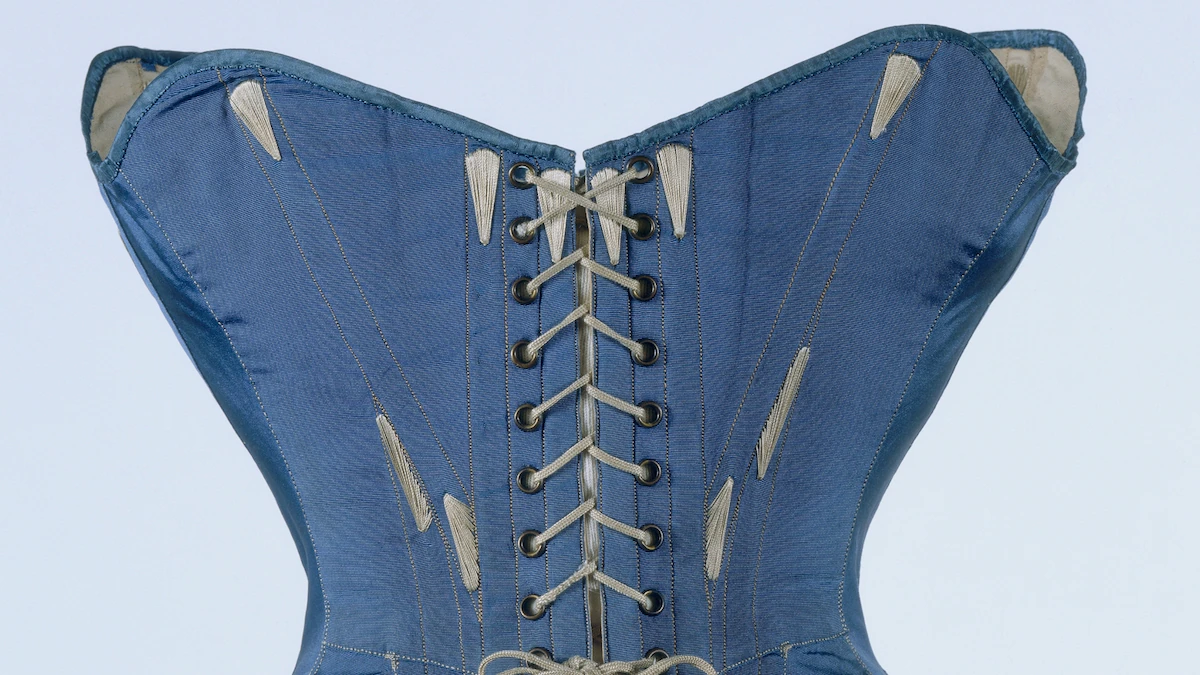
In a 2014 episode of RuPaul’sDrag Race, judge Michelle Visage eyes contestant Adore Delano’s sequined, strapless evening gown. “Are you cinched,” Visage, clearly displeased, asks, referring to the loose bodice of Delano’s gown. The camera pans to Delano’s slim natural waist. “No,” Delano answers. “I have hog body,” she says, referring to her natural waistline without the exaggerated proportions created by a corset. The phrase became an instant classic in Drag Race lexicon, the opposite of “snatched,” another popular term on the show with roots in 1980s and 90s ballroom culture, meaning to serve a flawless, smooth hourglass figure. In early seasons of the reality show, judges were unenthusiastic about natural waists and queens who eschewed padding.
In the years since Drag Race lent popularity to the term snatched, the concept has taken on a life of its own. In North America, the shapewear market is booming, with sales projected to rise to over $13 billion by 2033. In the mid-to-late 2000s, celebrities like Kim Kardashian revived the popularity of designer Hervé Léger’s bandage dress. By the early 2010s, the bodycon era was in full swing, fueling a need for tight, smoothing undergarments that create the illusion of a snatched waistline. But even as bodycon dresses fell out of fashion, the interest in shapewear remained. In 2019, Kardashian launched her own shapewear line, SKIMS, currently valued at $4 billion. Recently the compression craze has migrated from the waistline to the face as products like the SKIMS jaw bra, which promise to “snatch” wearers’ entire bodies from head to toe (even if they don’t necessarily live up to those promises).
But our cultural obsession with snatching goes back centuries. Keeping a tight face and a tight body through socially acceptable means such as exercise, support garments, and even tasteful, imperceptible plastic surgery has long been a symbol of both self-respect and respectability. The expectation that a well brought-up woman should modify her body through corsetry dates to the 16th century, when whalebone corsets, known then as “bodies,” were routinely worn by aristocratic women and girls, including Catherine de Medici and Queen Elizabeth I. Throughout Europe and the Americas in the 18th and 19th centuries, corsets served many functions. There were posture correcting corsets for children, corsets designed for support while performing physical labor, modified corsets for pregnant and breastfeeding women, even corsets designed for military men and early 19th-century dandies. In 1745, a Swiss visitor to England observed that even in the countryside “all go laced,” since, particularly in England, loose stays indicated loose morals.
As Valerie Steele notes in her book The Corset: A Cultural History, corsets conveyed “social status, self-discipline, artistry, respectability, beauty, youth, and erotic allure.” For upper-class women, displaying these traits was essential for displaying rank. For lower-class women, emulating the upper classes became a means of possibly attaining social mobility through marriage or employment.
Even as corsets fell out of fashion in the 1920s, a pulled together, or snatched, self-presentation remained important through diet, exercise, and other body modifications such as shapewear and plastic surgery. But while these standards have long been socially enforced, too much body modification, in the form of tight-lacing—not to mention modern procedures like liposuction, face-lifts, and fillers—was deemed unnatural, unhealthy, and attention-seeking. The history of snatching is a double-edged sword where, on one hand, those who went without corsets were labeled loose and slatternly, yet those who laced too tightly—who modified their bodies too obviously—were considered silly and vain.
(Face wraps promise a snatched jawline—but do they really work?)
The “silly women” who laced their corsets too tightly
The most enduring image we have of corsetry is the wasp-waisted tight-lacer, a figure of much controversy. According to Rebecca Gibson, Assistant Professor of Anthropology at Virginia Commonwealth University and author of The Corseted Skeleton: A Bioarchaeology of Binding, the public outrage and panic around tight lacing was a Victorian phenomenon and targeted those people, usually women (and sometimes men), who took the common practice of body modification through corsetry “too far.” While a standard corset might draw in the waist by one to two inches, reducing the size of the natural waist over time, a process Gibson likens to wearing braces, tight-lacers forced waists to extreme unnatural dimensions. Critics decried these unnaturally waspish waists, claiming to have seen some as small as 15 or 16 inches. As the Victorian periodical The Family Herald warned in a 1848 issue: “Women ought to measure from 27 to 29 inches round the waist…thousands are laced to 21, some to less than 20.”
In the mid-to-late 19th century, tight-lacers were the “bad girls” of their day, either seen as silly airheads who would mutilate their bodies for fashion, dangerous harlots constricting their waists for sexual gratification, or both. Steele writes that “anticorset literature was similar in tone and line of argument to diatribes on the terrible effects of masturbation and drinking.” Outrage over tight-lacers came from all sides: conservative writers scared of people expressing sexual agency through clothing and early feminist dress reformers demanding more egalitarian dress for women.
From 1867 to 1874, The Englishwoman’s Domestic Magazine published over 150 letters on the subject of tight-lacing, both in defense of and in opposition to the practice. According to Steele, many of those letters were thinly veiled pornography, with anonymous authors describing sadomasochistic encounters at tight-lacing schools. Letter writers, who largely claimed to have been teenage girls, described being sent to tight-lacing schools in London, Paris, and Vienna as punishment for wildness. While at the schools, they claimed to have been forcibly corseted by firm-handed headmasters and mistresses. Though these schools are believed by historians to be purely fictional, the letters, and others like them, were widely circulated in the respectable periodicals of the day, ostensibly consumed by readers who were also corseted. The fascination and fetishization of tight-lacing underscores the ways in which excessive body modification could be both a source of entertainment and a line of demarcation for cultural acceptability.
Some women gained widespread fame from their proactively exaggerated waists. French cabaret performer and early film star Polaire was an international phenomenon, in part, for her wasp waist. During the height of her career in the fin de siècle, she laced so tightly that her waist measured a circumference of just 16 inches and was often billed as a sort of side-show attraction. But even though tight-lacing was regarded as a “low-class habit,” as David Kunzel writes in Fashion and Fetishism, Victorian photographers routinely used retouching techniques and optical illusion to give sitters the wasp waist made fashionable by Polaire. In an 1895 issue of Photography Annual, photographer S. Herbert Fry wrote of using retouching techniques to routinely create “the exaggerated waist of a lady which measures but eighteen inches.”
The wasp waist, and the lengths to which wearers will go to get it, remains both a source of scorn and aspiration. At the 2019, Met Gala, Kim Kardashian made headlines for her dramatic hourglass shape in a flesh-toned Thierry Mugler gown embellished with crystal raindrops. Her small waistline left social media critics equally angered and envious; some were even concerned that she had a rib removed to achieve the look. But her snatched waist was the result of a custom-designed corset made by famed corset-maker Mr. Pearl (the corset required three people to put it on Kardashian and she reportedly took “corset breathing lessons”).
Much of the response to Kardashian’s look was almost Victorian. Multiple news outlets noted her “anxiety” over her corsetry. “Kim Kardashian laments painful Met Gala dress,” one headline read. Similarly, in 1887, the beauty writer Henry T. Finck complained that “the only satisfaction a woman can get from having a wasp waist is the envy of other silly women.” Dress reformers of the time agreed, arguing for the abolishment, or at least the loosening, of corsets. Their opposition made them strange allies for purported men of science who believed corsets to remove women from their “natural” maternal state:
“It has ceased to be a metaphor that [woman] is dressed to kill… Could your father or your husband live in your clothes?” early American critic of domestic femininity, Elizabeth Stuart Phelps, wrote in 1873. “Could he conduct his business and support his family in your corsets?”
Though they were at odds on most feminist issues, proponents of traditional gender roles, like American phrenologist O.S. Fowler, also argued against the corset. “It perverts the female character from its pristine loveliness into a bundle of artificial appearances, physically and mentally, leaving man’s heart desolated for want of a genuine woman to love and live for; when it even profanes the temple of female chastity,” Fowler wrote in 1870.
But according to Gibson, most critics were not as extreme in their views of corsetry as the dress reformers or those who argued that corsetry made liars of women who modified their bodies into unnatural shapes. “In Western Society, we like to find ways to punish women for decisions that are culturally influenced and almost inevitable in order to maintain power and popularity with one’s own cohort,” Gibson says.
Throughout the 18th and 19th centuries, literature and art mocked tight-lacers. An illustration from 1777 called Tight-Lacing depicts an older, ugly woman holding a bedpost while a servant laces her by pressing a foot against her bustle. An 1879 illustration called Considérations sur le Corset from the gentleman’s magazineLa Vie Parisienne shows a mistress of the house bracing herself against a mantle while her husband, servants, and even a dog strain at her laces from one side, an army of cupids pulling from the other. An 1898 illustration portrays a husband and a maid lacing a woman so tightly she splits in half. These cartoons suggested that tight-lacers were not corseting for reasons of respectability, but instead for the approval of other women or, worse yet, for attention. In The Complete Beauty Book of 1906, Elizabeth Anstruther recalled a young tight-lacer she claims to have spotted in a famous café:
“The girl had brought a waist naturally about twenty inches into a compass that looked not to be more than twelve, but was probably sixteen. The effect was so grotesque that people giggled audibly as she passed out.”
(Bras are older than you think—much older)
From corsets to plastic surgery
The shorter hemlines and looser waists of the 1920s, along with advancements in shapewear and undergarment materials, led to the demise of the corset, at least for daily wear, but the desire to be snatched remained. As medicine became professionalized, and plastic surgery became its own field, body modification moved to the operating theater—and surgeons promised a snatched look from head to toe.
In the early 20th century, doctors touted the benefits of paraffin wax as a solution to the depressed nose, a side effect of syphilis, a disease that was common until the 1940s, when it was discovered that penicillin was an effective cure. Liquid paraffin was injected into the depressions of the afflicted noses, giving patients the same filled look that collagen injections promise today. Though short-lived because of paraffin’s tendency to migrate when exposed to sunlight, the injections were also touted for their ability to smooth fine lines and wrinkles, piquing public interest. After rapid, life-changing advancements for improving the appearance of facial injuries during World War I, doctors, particularly American doctors, brought those innovations home, pioneering the first cosmetic surgeries, often rhinoplasties and face lifts. As this new form of fashionable body modification became more widespread, critics were quick to point out the ways that some people, mostly women, were taking it too far. As this new form of fashionable body modification became more widespread, critics were quick to point out the ways that some, mostly women, were taking it too far.
“I’m just crazy with joy,” a Parisian woman who had come to New York City for a facelift told The New York Times in the summer of 1920—though she had concerns about her newly snatched face. “I daren’t smile,” she said. “That would start the wrinkles all over again.” In the article, the Times was quick to invoke Hamlet, noting that sensibility “scorns all who, God having given them one face, make themselves another.”
Throughout the 20th century, debates around the morality, feminist implications, and cultural significance of plastic surgery would come to make the late-Victorian arguments around tight-lacing seem quaint. Early plastic surgeons argued that men who had been wounded in battle needed plastic surgery to find employment. Entertainers quickly jumped into the fray, hoping cosmetic alterations might improve the availability of roles, particularly roles for older women. Soon people from all walks of life argued that a more youthful appearance might improve their chances of career advancement or marriage, though the stigma around having plastic surgery to appear younger remained. In the late 90s and into the 2000s, celebrities suspected of surgically altering their faces made the covers of magazines. “Plastic surgery: Who cares?” read the cover of Jane magazine featuring actress Meg Ryan in 2004.
It turned out a lot of people cared: as injectables and fillers became more affordable, being snatched trickled down to the middle classes. The American Society of Plastic Surgeons reported that its licensed members performed 25.4 million “minimally invasive” cosmetic procedures in 2023—a number that grew nine percent from the previous year. Reality television stars and social media influencers became the bad girls of cosmetic procedures, snatching their faces as tightly as their waists, proving that billion-dollar empires could be built on body modification.
As Victoria Pitts notes in her history of contemporary body alterations, In the Flesh, “human bodies are always shaped and transformed through cultural practices.” However, when undergone by women, these procedures are often viewed as gendered forms of self-harm until they reach more widespread acceptability. Now, that change seems to have come for the filler-heavy look of the recent past. In popular social media videos, celebrities and influencers explain which surgeries they have, and have not had, alongside others who recount reversing previous cosmetic procedures.
Visage herself, once unenthused about Drag Race contestants who refused the snatched look, now hosts a show called Botched Presents: Plastic Surgery Rewind, in which participants are guided through the process of reversing procedures. Snatching has once again shifted in meaning. Rather than the cinched bombshell, it’s now a contoured but more natural-seeming body. The promise of the SKIMS jaw bra lies in a more natural approach to snatching, one that can be achieved at home by wearing the same compression garments used after cosmetic surgery to reduce swelling without the pain and costs of surgery itself.
“A few years ago, it was ‘the bigger, the better’. Bigger lips, bigger butts, bigger breasts,” says Dr. David Rosenberg, plastic surgeon at Rosenberg Plastics in Beverly Hills, California via email. “Now I hear ‘snatched’ all the time. They want smaller, more natural breasts, softer lips, and a more balanced figure. It feels less like ‘look at me’ and more like “she just woke up looking like this.”
Perhaps the newer streamlined, tighter look, is a reaction to the recent past in which plump cheeks, lips, and buttocks were de rigueur. As Gibson notes, changes tend to be cyclic, with waves of change following backlash: “Fashion itself usually goes on a 10-year cycle. You have a backlash, and then you have a backlash to the backlash. I think we are currently in a backlash to the last ten years.” As culturally acceptable body modification once again shifts towards effortless beauty, only time can tell who will be singled out for taking it too far–either through slattern sloppiness or attention-seeking vanity.



